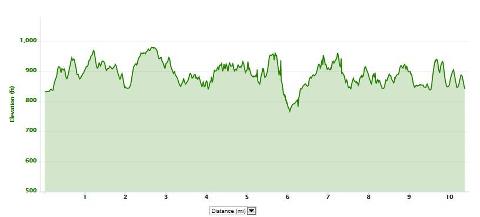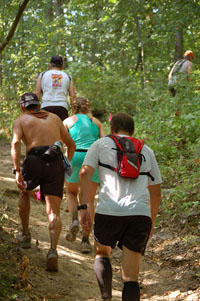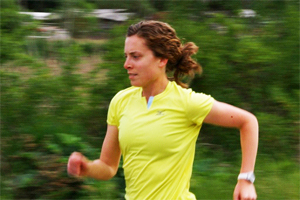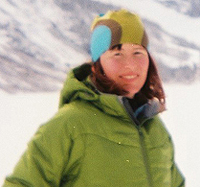By: Sophia Wharton
 It was my idea to make the Trail Nerds Psycho Psummer course 3 loops instead of 2. I pushed for it in the days where I was race directing 22 races a year with Ben Holmes and I got my way—after all, our Kansas runners love a ten mile race at Wyco. My brother Philip who is a composer of complex yet often delicate classical music once turned to me in a rehearsal as a trumpet and flute struggled to get their notes to match Philip’s written rhythms. There was nothing delicate about this collaboration.
It was my idea to make the Trail Nerds Psycho Psummer course 3 loops instead of 2. I pushed for it in the days where I was race directing 22 races a year with Ben Holmes and I got my way—after all, our Kansas runners love a ten mile race at Wyco. My brother Philip who is a composer of complex yet often delicate classical music once turned to me in a rehearsal as a trumpet and flute struggled to get their notes to match Philip’s written rhythms. There was nothing delicate about this collaboration.
He looked at me and the notes unfolded.
“It seemed like a good idea at the time.”
And so I give you this 3 loop course at Wyco. What seemed a good idea at the time as a co-race director was rather a different story as a runner.
Here is that story.
There I was towing the start line of the race in my Wave Elixir 7’s. And the 10 mile race was great. I ran with friends and we chatted. We made new friends and in fact at one point I was leading a party of 14. Five of us crashed through the 10 mile finish in 2:07. The only problem was, I was signed up for the 50k.
I hate running in the heat. The forecast for the day was for triple digits and even higher heat indexes. As I entered loop two I could feel the sun burning on my skin collaborating with the albatross of loop 3 hanging on my neck.
The course is about 87.4% shaded with the first half mile of each loop a flat, grassy baker.
Here is the course profile:

I entered the woods grateful for the shade and felt an odd shiver. I looked down and saw goose bumps on my arms and felt a peculiar shiver through my scalp. I knew it was heat exhaustion and I had over 20 miles to go. There were 3 tough miles to the next aid station and ice, so all I could do was pull back on the pace, which I did. I did not tell anyone of what would become my new running companion for nearly 5 hours.
Kansas isn’t flat. Seriously- there is 1500 feet of elevation change per loop on this course. Still, because of the plentiful aid stations, many runners choose this as their first Ultra.
An Ultramarathon is anything over 26.2 miles. With a 50k being just about a 10k more, many choose a 50 k as their first ultra distance. Over the years since my first official ultra, which ironically was the then 2 loop Psycho Psummer of 2008 , I’m asked what’s the difference in training and then why? Why put your body through such torture? I’ll answer the first question in a second- as to the second, I’ve always managed to run close enough to the bright side of the edge that the torture was never very intense.
On a very basic level, the training includes longer long runs (yes, 17 isn’t long-try 24. Thank you very much) and back to back long runs. So 24 on Saturday and a nice 12 to 15 on Sunday. The purpose of this is to get your legs used to running tired. Some folks up their mileage to 70 to 90 mile weeks. I haven’t trained that way, so I won’t speak to it. I run 40 to 64 and get in a decent amount of back to backs and it works well for me.
Those back to back runs are what bring us back to this race. I’m training for the Leadville 100 and needed Psycho Psummer with its constant ascents as run number one of two for the weekend. Dropping a loop to the 20 due to heat exhaustion just wasn’t an option, as 20 is hardly a long run.
 Loop 2 was such an arduous journey. I just couldn’t get dialed into the zone. I was running with a gal named Rochelle who is part of a trail group in Omaha. I was excited to meet her since Omaha is part of my Mizuno territory and it’s always nice when you’re on the road to find like- minded runners to hit the trails with.
Loop 2 was such an arduous journey. I just couldn’t get dialed into the zone. I was running with a gal named Rochelle who is part of a trail group in Omaha. I was excited to meet her since Omaha is part of my Mizuno territory and it’s always nice when you’re on the road to find like- minded runners to hit the trails with.
“I keep trying to tell myself that this is a race not a long run and I need to keep running even when I want to walk. You know you can always run just a little more than you think you can. But I can’t find my ZONE.”
We started walking up all the hills. Another aspect of ultra running, is how quickly and effectively hiking can get you to your destination and how much ultra runners walk in races. But my legs were stiff and I continued to dread the final loop. Psychologically, these two shorter loops seemed just as long as the two longer ones. Do you know the feeling you get when you send a letter or email and just want to jump into the mailbox and get it back? I wanted to shake the race director and say “I’m sorry, it was a terrible idea. Please just put the course back the way it was.” Unfortunately the new medals had just been cast, with 10-20-50k on them, and even had a bottle opener feature on the bottom the RD was very pleased with. The race will stay the same until those medals are gone.
By the time I got to my ultra-buddy Erica’s aid station, I felt depleted.
“Hot enough out there for you?” She was teasing and chipper.
The sound that came out of my mouth was a combination of a sigh and growl.
“Just get me some ice.”
Her demeanor instantly changed.
“I’ve got it. Coke? Anything else?” Erica knows me well and has shared many a joke and light moment. She knew at that moment, I had lost my sense of humor. Fortunately, she didn’t know I was pushing the red zone of heat exhaustion. I was having an affair with heat exhaustion, and when you’re having an affair, sometimes you can’t even tell your best friend.
Erica would see her share of suffering. One guy on the ground, blue in the lips and ultimately headed to the ER, while another sat on a bench vomiting.
The next section is a testament to trail building mediocrity. Single track that is wound so tight, you can barely get some steam on the down. I found myself behind runners who couldn’t even take advantage of what little this trail offers. I awkwardly passed. The worst part is that trail drops you at the bottom of a dam. There runners trudge the wobbly, sideways, grass surface, crossing two , two foot drainage ditches, all at an angle similar to a solar oven. My group of now 3 climbed up and headed into the shade, where there was yet another hill.
I shivered. I watched Rochelle enjoy a second wind. I climbed another hill. I cursed the dreaded 3rd loop. And I ran with Luke.
“I want to run with the Mud Babes.” Luke was referencing the women’s group within the Trail Nerds that I founded. It was his first 50k.
“Sophia, I remember hearing you say that the best way to finish an ultra is to go out for the final loop.”
While I wouldn’t admit to the heat exhaustion I did admit responsibility for the 3 loop course.
“It’s my fault. This course is three loops because of me.”
The last 4 miles to the finish had 2 aid stations. What seemed excessive on the first loop, became a lifesaver on number 2. The last mile and a half into the finish is a section everyone calls “3 hills.” On the first loop, I agree, but by loop two it seemed more like 4.
Loop 2 complete in 2:26.
For the final loop my plan was to pull back even further, suffer through and just hike it if I had to. I started to climb the first hill and noticed something interesting to accompany my shivers. My walking was no longer stiff. It was smooth, quick and powerful and I passed Rochelle going uphill.
“Ah Sophia, you’re in the zone.”
 I work for a Japanese company and admire their culture greatly. So much so, I’ve made up my own Japanese philosophy. It’s called OYO (pronounced oi-YO, with a real emphasis on the second syllable.)
I work for a Japanese company and admire their culture greatly. So much so, I’ve made up my own Japanese philosophy. It’s called OYO (pronounced oi-YO, with a real emphasis on the second syllable.)
It stands for On Your Own, but can only be used when you are successful and content on your chosen journey. I shout it out often as a cheer with my friends and for myself. I started a rhythmic journey of quick climbing and doing what I do best in races which is to make myself run just a little more than I think I can. Not run faster or harder, run more often and steadier. Alone with my thoughts and nature, I was happy-and also better able to monitor whether the shivers were getting worse and if any other symptoms of heat exhaustion were entering the mix.
As I approached the solar oven for the third time, I was baking- I started to wonder if runners ever wear those umbrella hats and if it would help. I wanted to walk the whole way- OYO or not. Instead I deployed a method I’ve used often when pacing others which I call 50 – 50’s. 50 steps walking, 50 steps running. Over and over until the uphill. Like many of the ups at Wyco, this one plateaus. Cresting the top all I wanted to do was walk more. I made myself run the 50 steps, reminding myself it really doesn’t hurt anymore to run than to walk.
I felt the creepy shiver like a wraith’s breath on my hot neck, but a new emotion had developed which goes with the Zone and OYO. Determination to at least finish under 7 hours. To do this, I knew I had to run every runnable portion and continue moving on the ups.
3 hills blossomed. I think I counted the third hill 3 times. Was this a joke? My legs now ached and I started to wonder how I’d make it through the Leadville 100. And the clock was ticking.
After the actual final hill, there was again a plateau, this time in the sun. I was truly feeling gross and reminded myself that pain is temporary and glory is forever. However, I also knew I was skirting a trip to the ER and wondered why I couldn’t hear the finish line. Turns out it was pretty hot there too and no one was making much noise.
After crossing the finish, I unleashed my dirty little secret.
No I didn’t want beer or a hot dog. I wanted ice on the back of my neck, under the knees, on top of the knees. It took 3 people with ice in both hands for 20 minutes to cool down my core. I’m told temperatures reached 104 (had the kind volunteer told me any lower than 98, I was going to punch someone.) I had run in the danger zone for 5 hours. One of the volunteers helping me was Megan Moriarty who is crewing me at Leadville 100.
“Megan- this is the worst I’ve ever been in an ultra. If I end up here when we’re there, we are in trouble.”
Heat is not for beginners and often not for experienced runners either. I ran in the danger zone for just under 5 hours. I could call it stupid. You could call me an idiot- but I can’t emphasize enough how completely in tune and engaged I was with everything my body was going through and how often I checked in and made adjustments to keep myself safe. Still, it was worse than any final 30 miles of the two 100’s I have completed.
My finish time was 6:54:21. My third loop- the one I dreaded the most… 2:19. 7 minutes faster than loop 2- and that my friends is good running. It is also good living and a good philosophy. Confront your fears head on and the results may surprise you. Loop 3- I own you. I love you and will never let you go, and although I’ve never been much for medals, since this one has the bottle opener, I love you too. It’s found its way into my kitchen drawer. OYO!



 It was my idea to make the Trail Nerds Psycho Psummer course 3 loops instead of 2. I pushed for it in the days where I was race directing 22 races a year with Ben Holmes and I got my way—after all, our Kansas runners love a ten mile race at Wyco. My brother Philip who is a composer of complex yet often delicate classical music once turned to me in a rehearsal as a trumpet and flute struggled to get their notes to match Philip’s written rhythms. There was nothing delicate about this collaboration.
It was my idea to make the Trail Nerds Psycho Psummer course 3 loops instead of 2. I pushed for it in the days where I was race directing 22 races a year with Ben Holmes and I got my way—after all, our Kansas runners love a ten mile race at Wyco. My brother Philip who is a composer of complex yet often delicate classical music once turned to me in a rehearsal as a trumpet and flute struggled to get their notes to match Philip’s written rhythms. There was nothing delicate about this collaboration.
 Loop 2 was such an arduous journey. I just couldn’t get dialed into the zone. I was running with a gal named Rochelle who is part of a trail group in Omaha. I was excited to meet her since Omaha is part of my Mizuno territory and it’s always nice when you’re on the road to find like- minded runners to hit the trails with.
Loop 2 was such an arduous journey. I just couldn’t get dialed into the zone. I was running with a gal named Rochelle who is part of a trail group in Omaha. I was excited to meet her since Omaha is part of my Mizuno territory and it’s always nice when you’re on the road to find like- minded runners to hit the trails with. I work for a Japanese company and admire their culture greatly. So much so, I’ve made up my own Japanese philosophy. It’s called OYO (pronounced oi-YO, with a real emphasis on the second syllable.)
I work for a Japanese company and admire their culture greatly. So much so, I’ve made up my own Japanese philosophy. It’s called OYO (pronounced oi-YO, with a real emphasis on the second syllable.)

 Nikki Reiter holds a master’s degree in biomechanics and is a Mizuno Running Brand Ambassador and the Women’s Cross Country Running Head Coach at the University of British Columbia Okanagan campus in Kelowna, BC. She is also the Laboratory Coordinator in the School of Health and Exercise Sciences at UBC Okanagan where she facilitates undergraduate laboratory learning.
Nikki Reiter holds a master’s degree in biomechanics and is a Mizuno Running Brand Ambassador and the Women’s Cross Country Running Head Coach at the University of British Columbia Okanagan campus in Kelowna, BC. She is also the Laboratory Coordinator in the School of Health and Exercise Sciences at UBC Okanagan where she facilitates undergraduate laboratory learning. Born in Nova Scotia and emigrating to British Columbia via Ontario and Alberta, Magi has been running the entire way. Primarily defined as a cross country ski racer, Magi has competed nationally and internationally in that sport. The highlight of her career was competing in the World University Games and the World Cup races in Canada in 2007. Cross country skiers rely heavily on running for cross training and Magi has become an accomplished trail and mountain runner, representing Canada at the World Mountain Running Championships in 2005 and the winning numerous national championships medals.
Born in Nova Scotia and emigrating to British Columbia via Ontario and Alberta, Magi has been running the entire way. Primarily defined as a cross country ski racer, Magi has competed nationally and internationally in that sport. The highlight of her career was competing in the World University Games and the World Cup races in Canada in 2007. Cross country skiers rely heavily on running for cross training and Magi has become an accomplished trail and mountain runner, representing Canada at the World Mountain Running Championships in 2005 and the winning numerous national championships medals. 




 Our Magazine
Our Magazine
